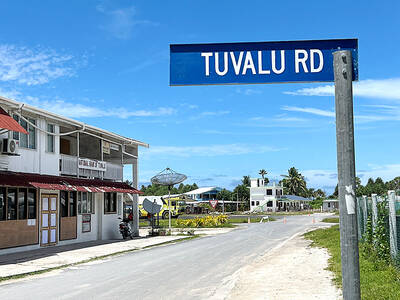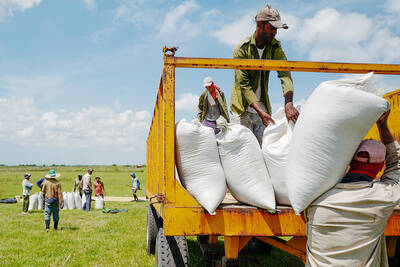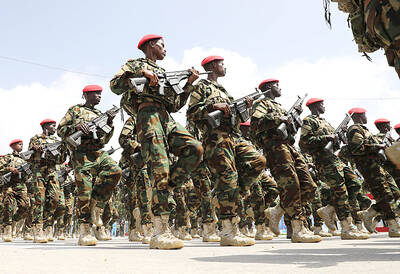Seven people have died in a Caracas slum due to heavy rains from Tropical Storm Matthew, which brought fresh misery to a region were hundreds have been killed in flooding and landslides this year.
An unrelated freak storm in Haiti killed at least five survivors from the devastating January quake and wounded dozens as it blasted through the capital, Port-au-Prince, tearing down shabby tent homes, trees and power lines.
Citing local fire department officials, Venezuela’s VNA state news agency said Tropical Storm Matthew killed its seven victims on Friday in the Santa Ana de Antimano neighborhood after their home was flooded.
Caracas fire chief William Martinez said authorities also conducted preventive evictions in other high-risk areas.
Thousands of people had been evacuated elsewhere in Central America ahead of Matthew, which made landfall in a lightly populated area of northeastern Nicaragua, then headed west, dumping rain across much of northern Honduras.
Rosalba Silva of Nicaragua’s Meteorology Institute said that the storm struck further south than had been expected.
At 3am GMT yesterday, Matthew’s center was located inland about 130km east-southeast of the coastal city of La Ceiba, the US National Hurricane Center said. It packed top winds of 85kph.
The storm was moving west-northwest at 24kph.
There have been no reports of victims or serious damage in Honduras, though the Honduran government expanded a red alert nationwide because Matthew threatened all 18 departments.
“This is a new threat. Tropical Storm Matthew has entered the territory, and we predict heavy rains throughout the country,” Honduran President Porfirio Lobo told reporters.
Randolfo Funez of the national emergency commission pointed to high water levels in rivers, noting that the soil was highly saturated after frequent rains since May.
About 10,000 Miskito Indians living on the Caribbean coast were evacuated ahead of the storm, Nicaraguan civil defense chief Mario Perezcassar said.
“Torrential rains will be the biggest threat for the next few days,” the National Hurricane Center said.
The eye of the storm was forecast to move across Honduras yesterday and today, reaching Belize and Guatemala late yesterday and today.
Matthew is a large storm, with tropical force storm winds extending outward up to 280km to the north of the center, the center said.
It was expected to produce total rain accumulations of 15cm to 25cm over portions of Honduras, Nicaragua, southern Belize and Guatemala, with up to 38cm in isolated areas.
“These rains could produce life-threatening flash floods and mud slides,” the center warned.
The storm was expected to weaken and lose its tropical storm status by today.
Central America is in the midst of one of the most intense rainy seasons in the past 60 years, with flooding and landslides that have killed more than 300 people and caused serious damage in recent months.
The storm was expected to approach Belize’s coast later yesterday and the country placed its entire coastline on a tropical storm watch.
Since the arrival of Tropical Storm Agatha in late May, heavy rain has swamped the region.
Guatemalan President Alvaro Colom has declared a “state of national emergency” due to the heavy rain and flooding, which has killed at least 36 people, left some 40 people missing, forced the evacuation of about 11,500 people and caused US$1.5 billion in damage.
Meanwhile, Hurricane Julia formed out in the eastern Atlantic with maximum sustained winds of 130kph. It was expected to become a tropical storm today.

FORUM: The Solomon Islands’ move to bar Taiwan, the US and others from the Pacific Islands Forum has sparked criticism that Beijing’s influence was behind the decision Tuvaluan Prime Minister Feletei Teo said his country might pull out of the region’s top political meeting next month, after host nation Solomon Islands moved to block all external partners — including China, the US and Taiwan — from attending. The Pacific Islands Forum (PIF) leaders’ meeting is to be held in Honiara in September. On Thursday last week, Solomon Islands Prime Minister Jeremiah Manele told parliament that no dialogue partners would be invited to the annual gathering. Countries outside the Pacific, known as “dialogue partners,” have attended the forum since 1989, to work with Pacific leaders and contribute to discussions around

END OF AN ERA: The vote brings the curtain down on 20 years of socialist rule, which began in 2005 when Evo Morales, an indigenous coca farmer, was elected president A center-right senator and a right-wing former president are to advance to a run-off for Bolivia’s presidency after the first round of elections on Sunday, marking the end of two decades of leftist rule, preliminary official results showed. Bolivian Senator Rodrigo Paz was the surprise front-runner, with 32.15 percent of the vote cast in an election dominated by a deep economic crisis, results published by the electoral commission showed. He was followed by former Bolivian president Jorge “Tuto” Quiroga in second with 26.87 percent, according to results based on 92 percent of votes cast. Millionaire businessman Samuel Doria Medina, who had been tipped

Outside Havana, a combine belonging to a private Vietnamese company is harvesting rice, directly farming Cuban land — in a first — to help address acute food shortages in the country. The Cuban government has granted Agri VAM, a subsidiary of Vietnam’s Fujinuco Group, 1,000 hectares of arable land in Los Palacios, 118km west of the capital. Vietnam has advised Cuba on rice cultivation in the past, but this is the first time a private firm has done the farming itself. The government approved the move after a 52 percent plunge in overall agricultural production between 2018 and 2023, according to data

ELECTION DISTRACTION? When attention shifted away from the fight against the militants to politics, losses and setbacks in the battlefield increased, an analyst said Recent clashes in Somalia’s semi-autonomous Jubaland region are alarming experts, exposing cracks in the country’s federal system and creating an opening for militant group al-Shabaab to gain ground. Following years of conflict, Somalia is a loose federation of five semi-autonomous member states — Puntland, Jubaland, Galmudug, Hirshabelle and South West — that maintain often fractious relations with the central government in the capital, Mogadishu. However, ahead of elections next year, Somalia has sought to assert control over its member states, which security analysts said has created gaps for al-Shabaab infiltration. Last week, two Somalian soldiers were killed in clashes between pro-government forces and